Doubling wind and solar: What the EU must do to reach its 2030 emissions target
The bloc's efforts to cut greenhouse gases by 55% below 1990 levels within a decade will require unpopular decisions and a huge amount of money, writes Wood Mackenzie's Murray Douglas
